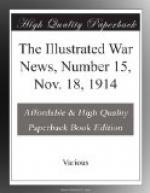_______________________________________________________
___________________ 44—The illustrated war news, Nov. 18, 1914.
[Illustration: “Six German shells to every French soldier”—Shrapnel and high-explosive bombs bursting in the open: A panoramic photograph taken during A battle in the Argonne. (left half)]
Nothing could give a better idea of shell-fire than the remarkable photograph here reproduced. It is a panoramic view of a German artillery bombardment of advancing infantry, and was taken in three sections, well within a hundred and fifty yards of some of the bursting shells. The locality of the battle is in the Argonne country between the Upper Aisne and the Meuse, where the French are having continuous and stiff fighting. Men of the French infantry keeping under cover in one of their advanced trenches are seen in the left foreground of the picture. The object of the actual fighting on the occasion was to keep apart the Third German army as it fell back towards prepared positions near the Meuse and a force of reinforcing troops coming up from the direction of Metz. “To impede the persistent advance of our —— corps.”
_______________________________________________________
___________________ The illustrated war news, Nov. 18, 1914—45
[Illustration: “Six German shells to every French soldier”—Shrapnel and high-explosive bombs bursting in the open: A panoramic photograph taken during A battle in the Argonne. (right half)]
writes a French correspondent on the spot, the enemy resisted vigorously and with his heavy artillery. He treated us to shells with a veritable prodigality, but without causing us very serious losses. In the forward movement, led by the —— infantry regiment, on an important position that had to be taken, practically every soldier engaged was saluted by six shells. There was, though, no ‘shyness’ among our men. They laughed and joked with one another as they quitted the trenches to move forward over the open. By the evening the enemy’s position had been taken.” Both ordinary shrapnel and high-explosive 15-c.m. shells from the German heavy position-batteries of howitzers, which weapons the Germans prefer for such work, although they also use guns of the same calibre, are seen bursting in front of the French troops.
_______________________________________________________
___________________ 46—The illustrated war news, Nov. 18, 1914.
[Illustration: Home after A German visitation: A room in A house at Nieuport after A shell had burst.]




